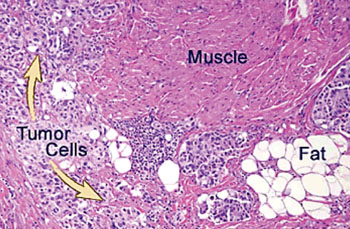Biopsy Quality Linked to Bladder Cancer Patient Survival
By LabMedica International staff writers
Posted on 13 Nov 2014
The quality of diagnostic staging using biopsy in patients with bladder cancer is directly linked with survival, meaning those that do not get optimal biopsies are more likely to die from their disease. Posted on 13 Nov 2014
Sometimes biopsies are only taken from tissue inner lining of the bladder itself, disregarding the underlying muscle wall. Muscle sampling which is often used as a surrogate for staging quality in patients with bladder cancer needs to be examined to determine the next course of treatment because the cancer may have started to invade the tissue from the muscle wall.

Image: Histopathology of a bladder with infiltrating high grade urothelial carcinoma, seen in muscle and fat (Photo courtesy of Johns Hopkins Pathology).
Physicians at the David Geffen School of Medicine (Los Angeles, CA, USA) working with their colleagues reviewed the medical records of every patient diagnosed with noninvasive bladder cancer during the years 2004 and 2005 across medical institutes in Los Angeles County. Biopsy and surgery reports were reviewed. The sample included 1,865 patients, and the reports from 335 urologists, and 27 pathologists.
Muscle was reported as present in 972, or 52.1%, absent in 564, or 30.2%, and was not mentioned at all in 329, or 17.7% of initial pathology reports. The presence of muscle did not differ according to the grade or depth of invasion. Mortality was statistically significantly associated with staging quality. Among patients with high-grade disease, the five year cancer-specific mortality rates were 7.6%, when muscle was present, 12.1% when muscle was absent, and 18.8% when not mentioned at all.
The authors concluded that the omission of muscle in the specimen or its mention in the pathology report in nearly half of all diagnostic resections was associated with increased mortality, particularly in patients with high-grade disease. Because urologists cannot reliably discern between aggressive and indolent disease, they recommended that patients with bladder cancer should undergo adequate muscle sampling at the time of endoscopic resection or biopsy.
Karim Chamie, MD, MSHS, an assistant professor of urology and lead author said, “These findings are very important because while patients know about the stage of their cancer, they rarely question the quality of the biopsy. Appropriately staging patients with bladder cancer is a skill set that every urologist and pathologist should have in their armamentarium. We believe the next step is to change the staging system for bladder cancer to incorporate the quality of staging. Not all stage I cancers are alike. Some patients may have stage II cancer, but because the biopsy was insufficient, these patients were inaccurately staged and may be undertreated. I really do believe that one reason why we have yet to see significant improvement in bladder cancer survival over the last two decades may, in part, be attributed to inadequate staging.” The study was published on October 22, 2014, in the journal Cancer.
Related Links:
David Geffen School of Medicine












.jpg)
